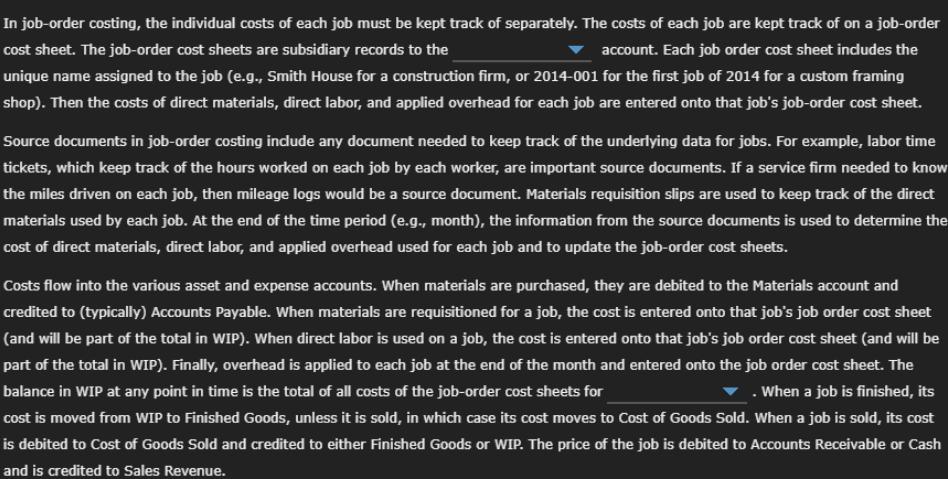Answered step by step
Verified Expert Solution
Question
1 Approved Answer
In job-order costing, the individual costs of each job must be kept track of separately. The costs of each job are kept track of

In job-order costing, the individual costs of each job must be kept track of separately. The costs of each job are kept track of on a job-order cost sheet. The job-order cost sheets are subsidiary records to the account. Each job order cost sheet indudes the unique name assigned to the job (e.g., Smith House for a construction firm, or 2014-001 for the first job of 2014 for a custom framing shop). Then the costs of direct materials, direct labor, and applied overhead for each job are entered onto that job's job-order cost sheet. Source documents in job-order costing indude any document needed to keep track of the underlying data for jobs. For example, labor time tickets, which keep track of the hours worked on each job by each worker, are important source documents. If a service firm needed to know the miles driven on each job, then mileage logs would be a source document. Materials requisition slips are used to keep track of the direct materials used by each job. At the end of the time period (e.g., month), the information from the source documents is used to determine the cost of direct materials, direct labor, and applied overhead used for each job and to update the job-order cost sheets. Costs flow into the various asset and expense accounts. When materials are purchased, they are debited to the Materials account and credited to (typically) Accounts Payable. When materials are requisitioned for a job, the cost is entered onto that job's job order cost sheet (and will be part of the total in WIP). When direct labor is used on a job, the cost is entered onto that job's job order cost sheet (and will be part of the total in WIP). Finally, overhead is applied to each job at the end of the month and entered onto the job order cost sheet. The balance in WIP at any point in time is the total of all costs of the job-order cost sheets for . When a job is finished, its cost is moved from WIP to Finished Goods, unless it is sold, in which case its cost moves to Cost of Goods Sold. When a job is sold, its cost is debited to Cost of Goods Sold and credited to either Finished Goods or WIP. The price of the job is debited to Accounts Receivable or Cash and is credited to Sales Revenue.
Step by Step Solution
★★★★★
3.42 Rating (161 Votes )
There are 3 Steps involved in it
Step: 1
1 The joborder cost sheets are subsidiary ...
Get Instant Access to Expert-Tailored Solutions
See step-by-step solutions with expert insights and AI powered tools for academic success
Step: 2

Step: 3

Ace Your Homework with AI
Get the answers you need in no time with our AI-driven, step-by-step assistance
Get Started


